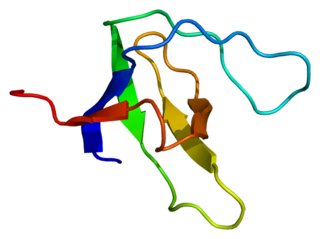
Podocytes are cells in Bowman's capsule in the kidneys that wrap around capillaries of the glomerulus. Podocytes make up the epithelial lining of Bowman's capsule, the third layer through which filtration of blood takes place. Bowman's capsule filters the blood, retaining large molecules such as proteins while smaller molecules such as water, salts, and sugars are filtered as the first step in the formation of urine. Although various viscera have epithelial layers, the name visceral epithelial cells usually refers specifically to podocytes, which are specialized epithelial cells that reside in the visceral layer of the capsule.

Focal segmental glomerulosclerosis (FSGS) is a histopathologic finding of scarring (sclerosis) of glomeruli and damage to renal podocytes. This process damages the filtration function of the kidney, resulting in protein presence in the urine due to protein loss. FSGS is a leading cause of excess protein loss—nephrotic syndrome—in children and adults. Signs and symptoms include proteinuria and edema. Kidney failure is a common long-term complication of the disease. FSGS can be classified as primary, secondary, or genetic, depending on whether a particular toxic or pathologic stressor or genetic predisposition can be identified as the cause. Diagnosis is established by renal biopsy, and treatment consists of glucocorticoids and other immune-modulatory drugs. Response to therapy is variable, with a significant portion of patients progressing to end-stage kidney failure. An American epidemiological study 20 years ago demonstrated that FSGS is estimated to occur in 7 persons per million, with males and African-Americans at higher risk.

Nephrin is a protein necessary for the proper functioning of the renal filtration barrier. The renal filtration barrier consists of fenestrated endothelial cells, the glomerular basement membrane, and the podocytes of epithelial cells. Nephrin is a transmembrane protein that is a structural component of the slit diaphragm. They are present on the tips of the podocytes as an intricate mesh and convey strong negative charges which repel protein from crossing into the Bowman's space.

The glomerular basement membrane of the kidney is the basal lamina layer of the glomerulus. The glomerular endothelial cells, the glomerular basement membrane, and the filtration slits between the podocytes perform the filtration function of the glomerulus, separating the blood in the capillaries from the filtrate that forms in Bowman's capsule. The glomerular basement membrane is a fusion of the endothelial cell and podocyte basal laminas, and is the main site of restriction of water flow. Glomerular basement membrane is secreted and maintained by podocyte cells.

Protein 4.1,, is a protein associated with the cytoskeleton that in humans is encoded by the EPB41 gene. Protein 4.1 is a major structural element of the erythrocyte membrane skeleton. It plays a key role in regulating membrane physical properties of mechanical stability and deformability by stabilizing spectrin-actin interaction. Protein 4.1 interacts with spectrin and short actin filaments to form the erythrocyte membrane skeleton. Mutations of spectrin and protein 4.1 are associated with elliptocytosis or spherocytosis and anemia of varying severity.

Zonula occludens-1 ZO-1, also known as Tight junction protein-1 is a 220-kD peripheral membrane protein that is encoded by the TJP1 gene in humans. It belongs to the family of zonula occludens proteins, which are tight junction-associated proteins and of which, ZO-1 is the first to be cloned. It was first isolated in 1986 by Stevenson and Goodenough using a monoclonal antibody raised in rodent liver to recognise a 225-kD polypeptide in whole liver homogenates and in tight junction-enriched membrane fractions. It has a role as a scaffold protein which cross-links and anchors Tight Junction (TJ) strand proteins, which are fibril-like structures within the lipid bilayer, to the actin cytoskeleton.

Protein tyrosine kinase 2 beta is an enzyme that in humans is encoded by the PTK2B gene.

Podocin is a protein that in humans is encoded by the NPHS2 gene.

Parathyroid hormone 2 receptor is a protein that in humans is encoded by the PTH2R gene.

Collagen alpha-4(IV) chain is a protein that in humans is encoded by the COL4A4 gene.

Na(+)/H(+) exchange regulatory cofactor NHE-RF3 is a protein that in humans is encoded by the PDZK1 gene.

Nephrocystin-1 is a protein that in humans is encoded by the NPHP1 gene.

CD2-associated protein is a protein that in humans is encoded by the CD2AP gene.

Regulator of G-protein signaling 7 is a protein that in humans is encoded by the RGS7 gene.

Synaptopodin is a protein that in humans is encoded by the SYNPO gene.

Leucine rich repeat containing 7 also known as LRRC7, Densin-180, or LAP1 is a protein which in humans is encoded by the LRRC7 gene.

Nephrocystin-3 is a protein that in humans is encoded by the NPHP3 gene.

Kin of IRRE-like protein 2, also known as NEPH3, is a protein that in humans is encoded by the KIRREL2 gene. It is primarily expressed in β cells of the pancreatic islets.

Kin of IRRE-like protein 3 (KIRREL3) also known as kin of irregular chiasm-like protein 3 or NEPH2 is a protein that in humans is encoded by the KIRREL3 gene.
Tobias Huber is a German nephrologist and internist. He is university professor and Director and Chairman of the III. Department of Medicine at the University Medical Center Hamburg-Eppendorf.




















